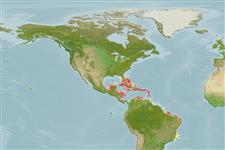Common names from other countries
Environment: milieu / climate zone / depth range / distribution range
Οικολογία
Θαλασσινό(ά) Υφαλόφιλο(α); εύρος βάθους 0 - 5 m (Ref. 9710). Tropical; 32°N -
Western Atlantic: Bermuda, southern Florida (USA), and Bahamas to Lesser Antilles and Central America (and probably northern South America). Antilles, Yucatan, Belize to Nicaragua (Ref. 26938).
Μέγεθος / Βάρος / Age
Maturity: Lm ? range ? - ? cm
Max length : 9.0 cm TL αρσενικό/απροσδιόριστο; (Ref. 7251)
Short description
Μορφολογία | Μορφομετρία
Ραχιαίες άκανθες (συνολικά): 19 - 21; Μαλακές ραχιαίες ακτίνες (συνολικά): 10-12; Εδρικές άκανθες 2; Μαλακές εδρικές ακτίνες: 19 - 21. Brown with 5 irregular dark brown bars on body, the anterior 3 of which extend basally into dorsal fin; no black spot on opercle; two dark brown dots or short lines posterior to eye; females with numerous dark dots in fins (Ref. 13442).
Occurs from rocky and rubble shores with algal mats to reefs and seagrass beds.
Life cycle and mating behavior
Γεννητική Ωρίμανση | Αναπαραγωγή | Γεννοβολία | Αβγά | Γονιμότητα | Προνύμφες
Robins, C.R. and G.C. Ray, 1986. A field guide to Atlantic coast fishes of North America. Houghton Mifflin Company, Boston, U.S.A. 354 p. (Ref. 7251)
IUCN Red List Status (Ref. 130435)
CITES (Ref. 128078)
Not Evaluated
Threat to humans
Harmless
Human uses
Ενυδρείο: Εμπορικό(ά)
Περισσότερες πληροφορίες
Κοινά ονόματαΣυνώνυμαΜεταβολισμόςΘηρευτέςΟικοτοξικολογίαΑναπαραγωγήΓεννητική ΩρίμανσηΓεννοβολίαΓονιμότηταΑβγάEgg development
Age/SizeΑύξησηLength-weightLength-lengthLength-frequenciesΜορφομετρίαΜορφολογίαΠρονύμφεςΔυναμική προνυμφώνΣτρατολόγησηΑφθονία
ΑναφορέςΥδατοκαλλιέργειεςΠροφίλ υδατοκαλλιέργειαςΣτελέχοιΓενετικήElectrophoresesΚληρονομικότηταΑσθένειεςΜεταποίησηMass conversion
Εργαλεία
Special reports
Download XML
Διαδικτυακές πηγές
Estimates based on models
Preferred temperature (Ref.
115969): 26.6 - 28.2, mean 27.5 (based on 516 cells).
Phylogenetic diversity index (Ref.
82804): PD
50 = 0.5078 [Uniqueness, from 0.5 = low to 2.0 = high].
Bayesian length-weight: a=0.00490 (0.00196 - 0.01224), b=3.09 (2.87 - 3.31), in cm Total Length, based on LWR estimates for this (Sub)family-body shape (Ref.
93245).
Τροφικό Επίπεδο (Ref.
69278): 3.8 ±0.6 se; based on size and trophs of closest relatives
Fishing Vulnerability (Ref.
59153): Low vulnerability (10 of 100).
